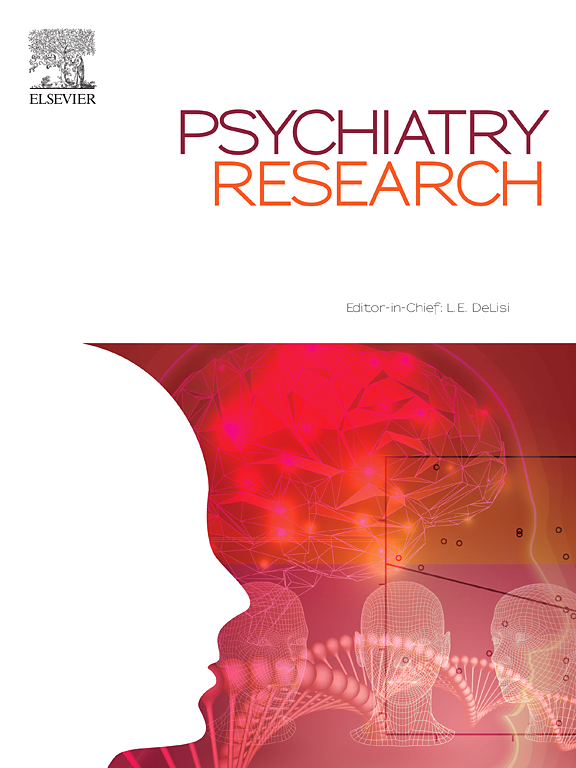From resting-state functional hippocampal centrality to functional outcome: An extended neurocognitive model of psychosis
IF 3.9
2区 医学
Q1 PSYCHIATRY
引用次数: 0
Abstract
Background
We previously proposed a neurocognitive model of psychosis in which reduced morphometric hippocampal-cortical connectivity precedes impaired episodic memory, social cognition, negative symptoms, and functional outcome. We provided support for this model in a patient subtype, and aimed to extend these findings to resting-state functional MRI to potentially explain the progression for a broader range of patients.
Methods
We used a subsample of our previous analysis consisting of 54 patients with first-episode psychosis and 52 controls and applied the machine-learning algorithm Subtype and Stage Inference, which combines clustering and disease progression modeling, to the patient data for rs-functional hippocampal connectivity, episodic memory, social cognition, negative symptoms and functioning.
Results
We identified three subtypes, with Subtype 0 being unimpaired on the markers, Subtype 1 showing impaired hippocampal connectivity and episodic memory, and Subtype 2 showing impaired memory and a trend for impaired functioning. We identified similar progression patterns to our previously published morphometric results in functional MRI data (hippocampal dysconnectivity preceded cognition, symptoms, and functioning in one subtype and followed these alterations in another subtype). We further show that the impairments in our previously published and current findings across modalities do not necessarily overlap in patients, hinting towards an additive effect of morphometric and resting-state connectivity in explaining the neurocognitive underpinnings of this model.
Conclusion
Our results provide an extension of our previous work and build the foundation for a multimodal neurocognitive model of psychosis, potentially elucidating this aspect of illness progression in psychosis for a broader range of patients.
从静息状态海马功能中心性到功能结果:精神病的扩展神经认知模型
我们之前提出了一种精神病的神经认知模型,其中海马-皮层形态连接的减少先于情景记忆、社会认知、阴性症状和功能结果的受损。我们在患者亚型中为该模型提供了支持,并旨在将这些发现扩展到静息状态功能MRI,以潜在地解释更广泛患者的进展。方法采用先前分析的54例首发精神病患者和52例对照患者的子样本,应用结合聚类和疾病进展建模的机器学习算法Subtype and Stage Inference,对患者的rs-functional海马连通性、情景记忆、社会认知、阴性症状和功能数据进行分析。结果我们确定了三种亚型,亚型0在标记上未受损,亚型1显示海马连通性和情景记忆受损,亚型2显示记忆受损和功能受损的趋势。我们在功能性MRI数据中发现了与之前发表的形态测量结果相似的进展模式(海马连通性障碍在一种亚型中先于认知、症状和功能,而在另一种亚型中紧随这些变化)。我们进一步表明,我们之前发表的和目前的研究结果在不同模式下的损伤在患者中并不一定重叠,这暗示了形态测量和静息状态连接的叠加效应,可以解释该模型的神经认知基础。结论:我们的研究结果为我们之前的工作提供了延伸,并为精神病的多模态神经认知模型奠定了基础,有可能为更广泛的患者阐明精神病疾病进展的这一方面。
本文章由计算机程序翻译,如有差异,请以英文原文为准。
求助全文
约1分钟内获得全文
求助全文
来源期刊

Psychiatry Research
医学-精神病学
CiteScore
17.40
自引率
1.80%
发文量
527
审稿时长
57 days
期刊介绍:
Psychiatry Research offers swift publication of comprehensive research reports and reviews within the field of psychiatry.
The scope of the journal encompasses:
Biochemical, physiological, neuroanatomic, genetic, neurocognitive, and psychosocial determinants of psychiatric disorders.
Diagnostic assessments of psychiatric disorders.
Evaluations that pursue hypotheses about the cause or causes of psychiatric diseases.
Evaluations of pharmacologic and non-pharmacologic psychiatric treatments.
Basic neuroscience studies related to animal or neurochemical models for psychiatric disorders.
Methodological advances, such as instrumentation, clinical scales, and assays directly applicable to psychiatric research.
 求助内容:
求助内容: 应助结果提醒方式:
应助结果提醒方式:


